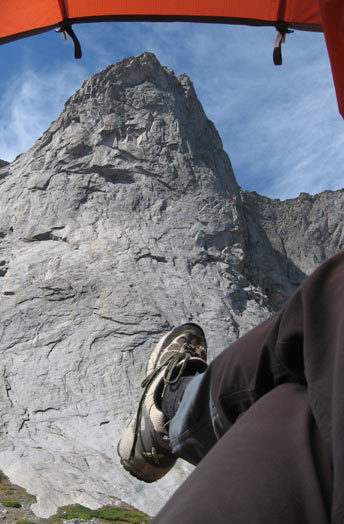
The ca. 1,500-foot northeast face of Ambush Peak, Wind River Range, Wyoming. The lack of good documentation in the range leaves many climbers uncertain whether they’ve established new routes or repeated existing lines. Such was the case in mid-August, when Renan Ozturk and Cedar Wright climbed a route they called Attack of the Killer Clowns (IV 5.11+ R, ca. 1,500′). Jonny Copp and Matt Segal climbed a 5.11+ line to the left (east) of Attack during the same time period. Neither party is certain their lines were new, but Ozturk and Wright’s crux pitch was riddled with chunks of loose rock, intimating its first ascent. [Photo] Cedar Wright
Some 800 feet up Ambush Peak in Wyoming’s spectacular Wind River Mountains in mid-August, Renan Ozturk and Cedar Wright faced a typical Ambush decision: Where to go? They were on the fin-like feature of the ca. 1,500-foot northeast face’s far right side, having free-climbed past low-down bail ‘biners and through steep cracks and intimidating overhangs on what seemed like virgin ground. After assessing his options, Wright decided the only way onward was up. He set off on sketchy 5.11 flakes and was “shocked yet thankful” to find an old quarter-inch bolt inscribed with “Banditos”–the infamous old-school climbing gang.
Ambush Peak, named by first ascensionist Fred Beckey (of course), rises from the East Fork Valley and lacks continuous and distinct lines, with climbing on flakes and intermittent cracks infused with quartzite. In the 1970s, Steve Arsenault established several routes on the northeast face with various partners, but as with most of the Winds, Ambush has a scantily recorded climbing history, making first-ascent information difficult and sometimes ambiguous. Still, as at least two pairs of adventurous climbers found this summer, not knowing is half the fun.
Just above the quarter-inch Bandito bolt, Wright yarded past a blank slab on a fixed bashie, and the pair continued to the top. Unsatisfied, they devised a plan to fix what was wrong with their climb: the five feet of aid. They rapped 600 feet back to the “where to go?” spot and found steep climbing, to the left of the Banditos passage, that comprised the crux pitch and led to the summit. Thinking it likely a new route, they named the line Attack of the Killer Clowns (IV 5.11+ R, ca. 1,500′).
Also climbing on Ambush in mid-August were Jonny Copp and Matt Segal. The pair climbed a route farther left (east face) of Ozturk and Wright’s likely new line, starting with several easy pitches up a gully and continuing on steeper terrain (up to 5.11) for another eight pitches to the summit. They found a bail anchor low down and no further traces higher up–and atop a 5.11+ pitch that dead-ended they left their own bail anchor, rapped to a ledge and found another way. First or not, they found fun, roofy, and spicy climbing with circuitous routefinding. “The Winds are peppered with shit like that,” says Copp, going on to list a number of accomplished climbers he knows who’ve climbed in the Winds over the years and not recorded their ascents, “so it’s hard to say if it was new or not. It’s definitely adventure climbing though, regardless.”
A couple of days before their experiences on Attack of the Killer Clowns, Ozturk and Wright had headed toward Ambush’s intimidating and chossy-looking Northeast Face route (Arsenault-Young, 1971), originally rated 5.8 A4. Though unclear whether Ozturk and Wright climbed the exact same line as the 1971 route, they made a one-day free ascent at 5.10+ R/X. Surprisingly, the rock quality turned out to be superb. “Who knows?” said Wright of the experience. “Maybe someday someone will even repeat our routes–unless of course they’ve already been climbed before!”